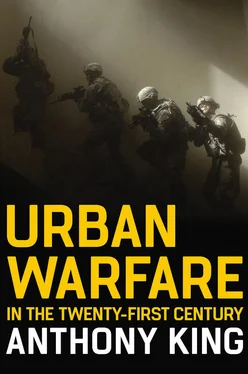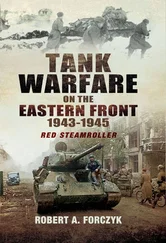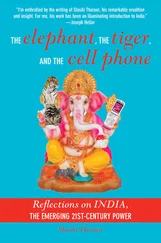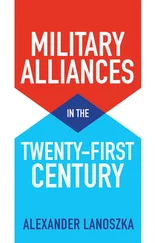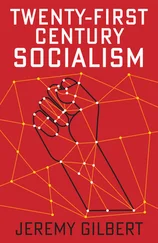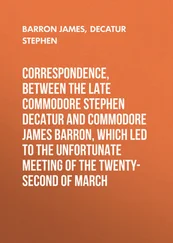Because of the objective decline in troop numbers, states have necessarily deployed much smaller forces on recent operations than in the twentieth century. They simply cannot mount mass operations anymore. This is even true for the IDF. Although the IDF remains a large conscript force, which has apparently maintained its size since 1991, only small elements of it were ever deployed on Israel’s recent campaigns. 27During the First Lebanon War of 1982, 78,000 troops were deployed. By contrast, 10,000 Israeli troops fought in the Second Lebanon War of 2006; only in the very last few days of the war, after a series of defeats, did the IDF increase the deployment to 30,000. 28Similarly, Operation Cast Lead against Hamas in Gaza in 2008 also involved a relatively small ground deployment of about 10,000 troops. If Duffy’s thesis is correct, then the reduction of combat densities on the battlefield should be expected in and of itself to increase the frequency of urban fighting. Reduced state forces necessarily converge on cities and towns.
Fronts: Twentieth-Century Warfare
In order to understand the significance of declining force sizes to urban warfare today, it is useful to consider the twentieth century, as both comparison and contrast. Urban warfare was, of course, by no means irrelevant during this period. In the First and Second World Wars, armies sometimes fought directly for possession of major and capital cities such as Antwerp, Leningrad, Moscow, Stalingrad, Manila, Warsaw and Berlin, as well as a host of smaller towns and cities such as Brest and Aachen. The grand strategic aim of the protagonists in both wars was to defeat their opponents’ field armies and to occupy their capitals. Cities were typically the operational and strategic objectives and, sometimes, serious fighting took place in them. 29
However, throughout the twentieth century, armies were so big that they campaigned in the field. In the First World War, Russia, France, Germany, Britain and the United States raised, respectively, armies of 12 million, 8 million, 11 million, 8 million and 4 million. In the Second World War, they fielded armies of 12 million, 5 million, 10 million, 4 million and 8 million respectively. In each major land campaign, the mass citizen armies of these nations formed fronts. There were three reasons for this. Fronts allowed armies to bring all their combat power to bear. It was also necessary to form a front in order to avoid being outflanked by the huge hosts that opposed them. Finally, but no less importantly, mass armies could be supported logistically only if they spread out across a large rail and road system; fronts protected their rear areas. The implications for urban warfare were profound. Because armies gathered on large fronts, twentieth-century armies predominantly fought for cities, outside them.
Perhaps the best example of the distinctive topography of twentieth-century warfare is provided by the most famous urban battle of the Second World War: Stalingrad. Stalingrad has rightly fascinated and appalled military historians and novelists alike. Not only was it one of the most savage engagements of the war, but it is plausibly held as the turning point of the conflict in Europe. Much of the historiography of Stalingrad has focused on the urban combat between August and November 1942. This is totally understandable. The fighting that took place inside the city was among the most intense of all the urban battles that took place during the Second World War. It was the first time that mass industrial armies, fully equipped with modern weaponry of machine guns, tanks, artillery and airpower, had been involved in a sustained battle against each other inside a city.
Stalingrad has been taken as the avatar of modern urban warfare, then. At the tactical level, this may be true. Yet, the Stalingrad campaign also exemplified the wider geometry of twentieth-century warfare. While they were the most intense and important actions, Sixth Army’s operations in Stalingrad were only part of much wider German Army campaign on this front. Sixth Army was part of the Wehrmacht’s redesignated Army Group B (formerly Army Group South), which orchestrated a wide-ranging campaign across a front, hundreds of miles north and south of Stalingrad. Stalingrad itself was not a particularly large city; in July 1941 it had a population of 900,000. 30Most of the Wehrmacht’s Army Group B, which consisted of the Fourth Hungarian, Third Rumanian, Fourth Rumanian, Eighth Italian, Fourth Panzer, Second and Sixth Armies (1.5 million men), was deployed not into Stalingrad, but into the field around it. 31Army Group B comprised seventy-four divisions in total. Only the twenty-seven divisions of the Sixth Army and Fourth Panzer Army were ever committed to the fight in and around Stalingrad itself. The rest were deployed on the Russian steppes. 32The Sixth Army was responsible for taking the city. It consisted of seventy divisions organized into four corps. 33Even at the climax of the battle in November 1942, during the assault on the Barrikady Gun and Red October factories, only LI Army Corps’ eight divisions (389 Infantry, 305 Infantry, 14 Panzer, 79 Infantry, 100 Jäger, 295 Infantry, 24 Panzer and 71 Infantry) were directly committed to urban combat at any one time, while the other divisions were deployed well outside the city defending German lines to the north. 34The Red Army’s deployment was similar. Only the Sixty-Second Army under General Vasili Chuikov fought in the city itself. In the course of the battle, Chuikov commanded thirteen divisions and some additional brigades; it was a very large force but constituted only about 15 per cent of the Red Army’s total forces in the theatre. 35Eight Soviet Armies, consisting of more than sixty divisions, eventually executed Operation Uranus in November 1942, encircling the Sixth Army. While the most intense fighting certainly took place in Stalingrad itself, where combat forces were most highly concentrated, the majority of German and Soviet troops were never deployed into the city. On the contrary, the battle in Stalingrad was part of a larger campaign fought along a front in the field (see Map 2.1).
It might be thought that Stalingrad was unique. Yet, this would be wrong. Allied campaigns in this period assumed a similar geometry. For instance, during the Normandy Campaign of 1944, Caen constituted the crucial hub of the whole theatre. The city was eventually destroyed by air bombardment. Yet, there was hardly any ground fighting in the city itself. The Allied Front enveloped Caen, which General Bernard Montgomery, the commander of the 21st Army, sought to take by a series of assaults – Operations Perch, Epsom, Charnwood and Goodwood – around its flanks in June and July. 36It is no accident that Normandy was remembered primarily for the difficulty of fighting in the bocage , not for urban combat. The topography evident during the Stalingrad campaign pertained for most of the twentieth century. NATO and the Warsaw Pact prepared themselves for a lineal field campaign along the Inner German border to the very end of the Cold War. 37
It is noticeable that military doctrine throughout the twentieth century typically recommended that armies avoid fighting in cities. 38This has often been interpreted today as evidence of the unique difficulty of such battles, both then and now. This is not a complete misreading of military doctrine; urban fighting was demanding, and was recognized as such. However, in fact, twentieth-century military doctrine recommended avoiding cities not primarily because they were so much more impenetrable than field defences – the Western Front in the First World War showed how formidable field fortifications could be. Rather, urban fighting was to be avoided because, with mass armies deployed, the main element of the enemy’s force was almost certainly to be found in the field – not in the town. It was, therefore, a mistake to commit forces to attacking a town, when the centre of gravity was elsewhere. This is why commanders were warned against it: ‘Tactical doctrine stresses that urban combat operations are conducted only when required and that built-up areas are isolated and bypassed rather than risking a costly, time-consuming operation in this difficult environment.’ 39Commanders often followed the advice. At Aachen in 1945, for instance, the US Army’s VII Corps assigned only two battalions to clear the city, while concentrating its forces further to the east of the city against the main element of the German Army on the Siegfried Line. 40In the Philippines, the Japanese Army did not think that Manila should be defended at all and sought to defeat the American forces in the mountains outside it. 41At Stalingrad, German generals catastrophically forgot the injunction.
Читать дальше
